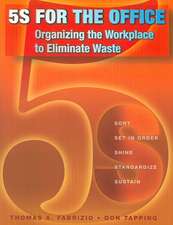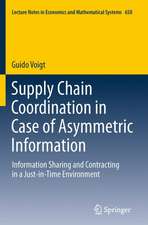Design for Environment as a Tool for the Development of a Sustainable Supply Chain
Autor Maurizio Bevilacqua, Filippo Emanuele Ciarapica, Giancarlo Giacchettaen Limba Engleză Paperback – 22 feb 2014
Be considering this new approach to the supply chain, environmental responsiveness can work in tandem with sounds business management. The usual focus on suppliers, manufacturers and customers is expanded in Design for Environment as a Tool for the Development of a Sustainable Supply Chain to include stakeholders such as government bodies and recycling companies. The influence of these additional groups is analyzed alongside concepts such as:
Product life cycle development aimed at environmental impact minimization;
Supplier selection and management based on environmental criteria; and
Marketing and communication choices which increase the value of environmentally sensitive products.
By including several case studies alongside theoretical topics, Design for Environment as a Tool for the Development of a Sustainable Supply Chains acts as a foundation for professionals across the supply chain, from industrial designers to marketing and sales departments, who are involved in environmental issues.
| Toate formatele și edițiile | Preț | Express |
|---|---|---|
| Paperback (1) | 948.16 lei 6-8 săpt. | |
| SPRINGER LONDON – 22 feb 2014 | 948.16 lei 6-8 săpt. | |
| Hardback (1) | 952.89 lei 6-8 săpt. | |
| SPRINGER LONDON – 5 ian 2012 | 952.89 lei 6-8 săpt. |
Preț: 948.16 lei
Preț vechi: 1156.29 lei
-18% Nou
Puncte Express: 1422
Preț estimativ în valută:
181.49€ • 197.20$ • 152.55£
181.49€ • 197.20$ • 152.55£
Carte tipărită la comandă
Livrare economică 21 aprilie-05 mai
Preluare comenzi: 021 569.72.76
Specificații
ISBN-13: 9781447159940
ISBN-10: 1447159942
Pagini: 384
Ilustrații: X, 374 p.
Dimensiuni: 155 x 235 x 20 mm
Greutate: 0.52 kg
Ediția:2012
Editura: SPRINGER LONDON
Colecția Springer
Locul publicării:London, United Kingdom
ISBN-10: 1447159942
Pagini: 384
Ilustrații: X, 374 p.
Dimensiuni: 155 x 235 x 20 mm
Greutate: 0.52 kg
Ediția:2012
Editura: SPRINGER LONDON
Colecția Springer
Locul publicării:London, United Kingdom
Public țintă
ResearchCuprins
From the Contents: Integration of Design for Environmental Concepts in Product Life Cycle.- Case Study: LCA as a Tool in “Design for Environmental”: A Comparative Study Between Domestic Refrigerators.- Sustainable Product Assessment Tools.- Case Study: The Domestic Cooker Hood “F77”.- Designers' Utilization of DfE and Requirements.
Notă biografică
Maurizio Bevilacqua, a full professor in Production and Operation Management at the Università Politecnica delle Marche, Ancona, Italy (formerly Università di Ancona) graduated with distinction in 1986 in Mechanical Engineering from the University of Ancona.
His research activity mainly deals with environmental analysis of process plants, maintenance management, life cycle assessment, project management and supply chain management. He is the author of several papers that have been published in several national and international journals (Journal of Cleaner Production, Journal of Sustainable Engineering, International Journal of Production Research, Journal of Food Engineering, Production Planning & Control, Reliability Engineering and System Safety, Quality and Reliability Engineering International, International Journal of Quality and Reliability Management, Journal of Loss Prevention in the Process Industries, International Journal of Production Economics, Business Process Management, International Journal of Logistics, International Journal of Operations and Production Management, The Journal of Enterprise Information Management) and also in conference proceedings.
His research activity mainly deals with environmental analysis of process plants, maintenance management, life cycle assessment, project management and supply chain management. He is the author of several papers that have been published in several national and international journals (Journal of Cleaner Production, Journal of Sustainable Engineering, International Journal of Production Research, Journal of Food Engineering, Production Planning & Control, Reliability Engineering and System Safety, Quality and Reliability Engineering International, International Journal of Quality and Reliability Management, Journal of Loss Prevention in the Process Industries, International Journal of Production Economics, Business Process Management, International Journal of Logistics, International Journal of Operations and Production Management, The Journal of Enterprise Information Management) and also in conference proceedings.
Textul de pe ultima copertă
Environmental Design is becoming an increasingly significant agenda for many manufacturing companies and yet there is no standard to their approaches, strategies or their levels of execution. Applying Design for Environment (DfE) methodologies to develop a more sustainable supply chain has formed procedures and techniques which allow designers to integrate these methods with environmental supply chain management. Design for Environment as a Tool for the Development of a Sustainable Supply Chain aims to define relevant target specifications for a product throughout its life cycle; from conception and design to the end of its operating life.
Be considering this new approach to the supply chain, environmental responsiveness can work in tandem with sounds business management. The usual focus on suppliers, manufacturers and customers is expanded in Design for Environment as a Tool for the Development of a Sustainable Supply Chain to include stakeholders such as government bodies and recycling companies. The influence of these additional groups is analyzed alongside concepts such as:
· Product life cycle development aimed at environmental impact minimization;
· Supplier selection and management based on environmental criteria; and
· Marketing and communication choices which increase the value of environmentally sensitive products.
By including several case studies alongside theoretical topics, Design for Environment as a Tool for the Development of a Sustainable Supply Chains acts as a foundation for professionals across the supply chain, from industrial designers to marketing and sales departments, who are involved in environmental issues.
Be considering this new approach to the supply chain, environmental responsiveness can work in tandem with sounds business management. The usual focus on suppliers, manufacturers and customers is expanded in Design for Environment as a Tool for the Development of a Sustainable Supply Chain to include stakeholders such as government bodies and recycling companies. The influence of these additional groups is analyzed alongside concepts such as:
· Product life cycle development aimed at environmental impact minimization;
· Supplier selection and management based on environmental criteria; and
· Marketing and communication choices which increase the value of environmentally sensitive products.
By including several case studies alongside theoretical topics, Design for Environment as a Tool for the Development of a Sustainable Supply Chains acts as a foundation for professionals across the supply chain, from industrial designers to marketing and sales departments, who are involved in environmental issues.
Caracteristici
Sets target specifications for the product and its life cycle Establishes eco-design concepts Uses environmental management case studies to better explain the theoretical topics Includes supplementary material: sn.pub/extras















